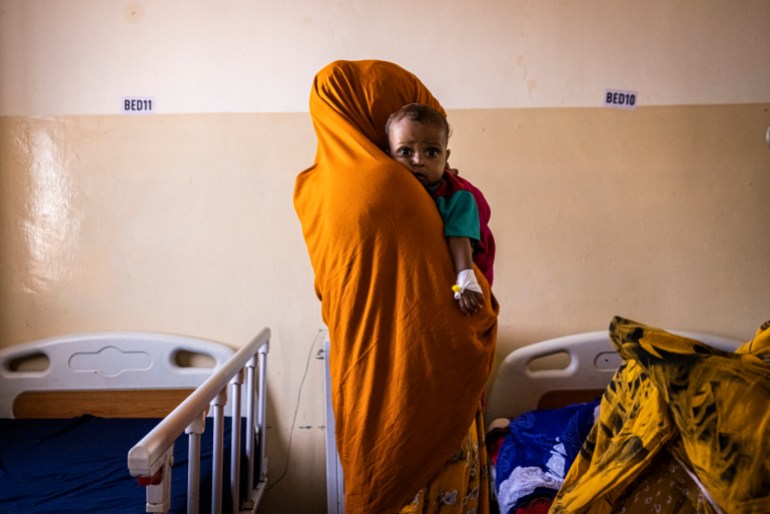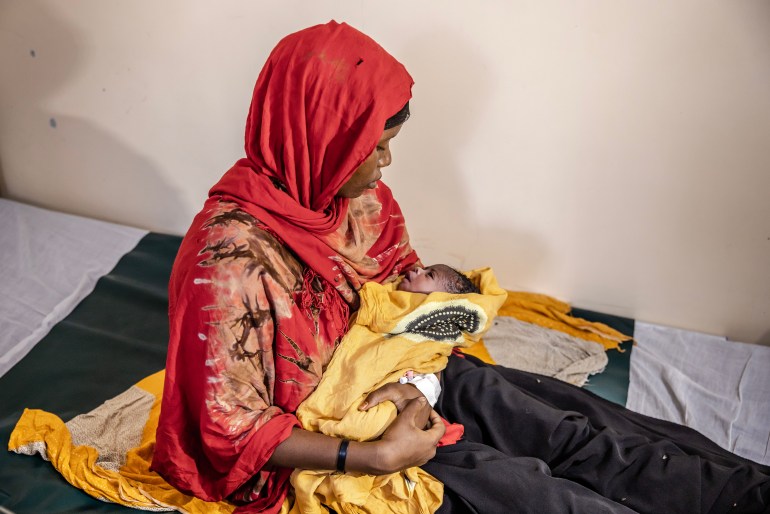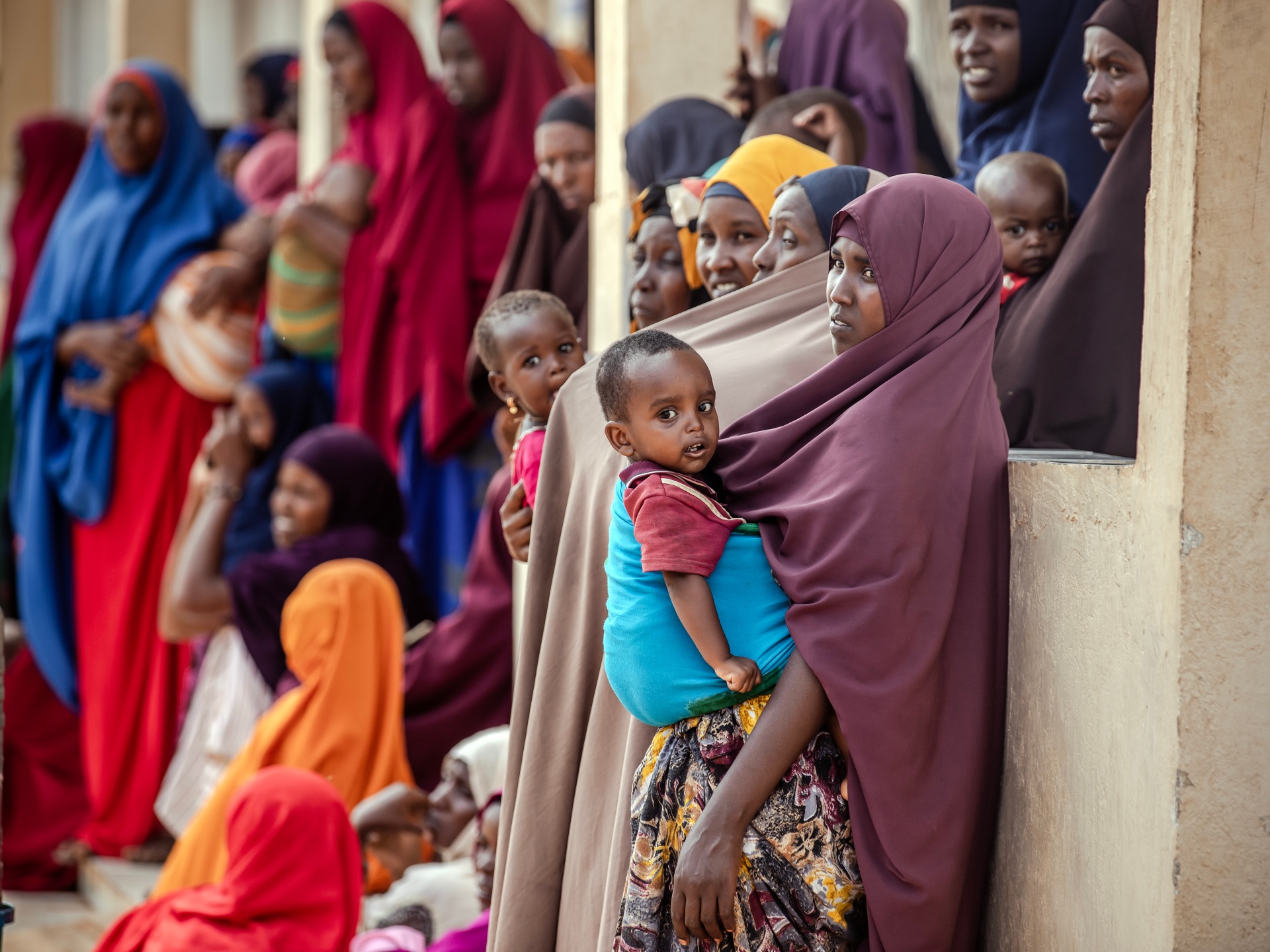It was early November when Aisha Hussein, nine months pregnant with her first child, felt the start of labour pains and knew she needed to make her way to a health centre from her village of Mareerey in Somalia’s Jubaland state.
She boarded a minibus taxi and, after a tedious four-hour journey, the 16-year-old arrived at the mother and child hospital in Kismayo, a coastal city about 100km (62 miles) away.
It was the first time in her pregnancy that Hussein saw a doctor. Distance and the cost of seeking care held her back, she said, especially because of the drought. “I didn’t have money to access the nearest free maternal facility in Kismayo on time since we lost all our income from farming and couldn’t afford transport money,” she told Al Jazeera over the phone from Kismayo.
Somalia is grappling with its worst drought in 40 years, and the United Nations Population Fund (UNFPA) in the country says this has threatened and displaced more than 1.9 million women and girls of reproductive age.
Mareerey, once a thriving agricultural village, is now deserted as a result of the dry spell. When Hussein reached the health centre that day, the ward was full of yawning and coughing women and children, many of them gaunt, suffering the effects of months of displacement and hunger.
“I was also weak when I was admitted because I used to stay hungry for days while I was pregnant, and it was as a result of the severe drought,” Hussein said.
The healthcare staff took her in for a medical assessment, but there were complications. After four days of bleeding and health staff monitoring the baby, Hussein was admitted to the theatre to undergo caesarean section surgery. But tragically, she lost her baby girl.
“I feel pain, but it’s God’s grace; God has given me before, and he has taken away; what can I do? Nothing,” an emotional Hussein said.
She is now under medical supervision and convalescing.
Mahat Ali, a doctor at Kismayo general hospital who attended to Hussein, said she was lucky to survive. “She was malnourished and has suffered prolonged vaginal bleeding and intrauterine growth restriction, and as a result, her baby was 2.3 kilogrammes, which is below the normal birth weight,” Ali the doctor, told Al Jazeera.
“My malnourished body had an impact on the baby in the womb,” Hussein said.
‘Facing famine’
According to the UN, nearly half of Somalia’s population – 7.6 million people – need urgent assistance because of the drought.
Somalia’s maternal mortality rate is one of the highest in the world, with a ratio of 692 deaths per 100,000 live births, and the UN says drought and displacement have stretched already limited sexual and reproductive health services.
Malnutrition among pregnant and lactating women is also soaring, posing severe risks to their health and wellbeing. Hussein’s doctor said that even if her baby had made it, the malnourished mother could not have breastfed her.
Approximately 600km (372 miles) from where Hussein was admitted, Noorta Ali, 21, a mother of four and a farmer, lives in an overcrowded and poorly equipped camp for internally displaced people (IDPs) on the outskirts of Baidoa, southern Somalia.
After three consecutive failed rainy seasons in Awdiinle – a once agriculturally rich village 30km west of Baidoa where she used to live – Ali lost all her crops. “We didn’t have clean water to drink and anything to eat; we lost all our crops since there was no rainfall and no income,” Ali told Al Jazeera over the phone.
The drought’s wide-ranging effects have had a devastating effect on her farming activities, and her life.

Like Hussein, Ali did not see a doctor while pregnant last year, and she lost her newborn baby. “I gave birth in a village where the only option is a traditional midwife,” she explained. “I was struggling to provide for my family and didn’t think of my pregnancy; as a result, I lost my three-days-old underweight baby after he suffocated in the cervix,” she said.
After that, she fled the village with her remaining four children. She is being treated for anaemia, malnourishment and skin diseases at the internally displaced persons’ (IDP) camp where they live.
A recent report by UNFPA, the UN’s sexual and reproductive health agency, says access to healthcare, including family planning and maternal health, has been severely compromised in districts of Somalia that are at risk of famine.
“Nearly a quarter of a million women are currently pregnant, and 80,000 will give birth in the next three months – an average of 900 deliveries a day – in a country where maternal mortality rates are already high,” the report reads.
“Also 15 percent of all pregnant women in Somalia experience complications, implying 12,400 complicated deliveries in the next three months in the displaced population,” it continues.
The report further says that each of these numbers is a woman or girl of reproductive age who has been enduring challenging times, including severe drought, rising food prices, severe water shortages, death of livestock and the loss of livelihoods.
Somalia’s envoy for drought response, Abdirahman Abdishakur, says a disaster will happen unless there is an urgent intervention by the international community. “All concrete indications show the country is facing famine and 80 percent of the affected people are the women, children and the elderly, and if there is no adequate funding to respond, there will be a catastrophe in Somalia as a result of the climate change impact,” he told Al Jazeera.
‘I couldn’t feed my children’
Natalia Kanem, UNFPA’s executive director, said the agency is working with other UN agencies to address some of the concerns, including scaling up the delivery of life-saving reproductive health and protection services.
“We are appealing for $79.4 million in Somalia for the remainder of 2022 and through 2023 as part of our Horn of Africa drought response and call on the international community to fund reproductive health and gender-based violence prevention and response services, including mental health and psychosocial support,” Kanem told Al Jazeera.
On top of the daily struggle to survive, the UN says at least 720,000 Somali women and girls are at risk of gender-based violence.
The high prevalence of violence against women comes as they now make longer journeys to obtain food or water, which leaves them vulnerable to sexual assault. Out of the nearly two million displaced women and girls of reproductive age, UN data shows there has been a 21 percent increase in reported rape cases in drought-affected communities since 2021.

At the same time, there is a dire need for more mental health support for those depressed in the camps, aid officials say.
In a makeshift camp in the Dolow district, Asma Adan, 29, from Gof-gaduud, a village northwest of Baidoa, says her depression was triggered by losing everything to the drought, including crops and livestock.
“The worst was when I couldn’t get anything to feed my children for two days and had no clean water. My children and I become malnourished, and that has deeply affected my mental health,” Adan, who lives with her four children in the camp, told Al Jazeera. “I also lost my menstruation period because of the depression.”
She is now being treated for a pelvic infection at Dolow health centre.
Hussein, despite her young age, used to be her family’s primary caregiver in Mareerey. She says this is the worst drought she has experienced and it has upended their lives.
“I’m praying to God that we will overcome this and hope to go back to my rural area and the farming activities and rebuild my life,” Hussein said, still holding on to hope.
